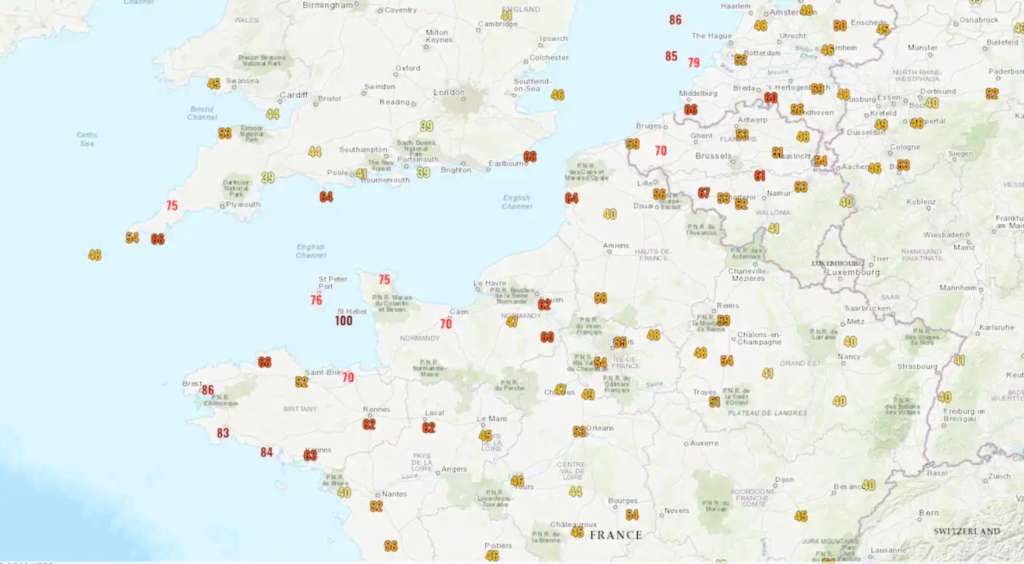Storm Ciarán Sweeps Across the UK Following Disruptive Winds and Power Outages in France
A massive and potent tempest that swept through northwestern France overnight was now impacting the United Kingdom on Thursday.

Storm Ciarán Sweeps Across the UK
LONDON— A massive and potent tempest that swept through northwestern France overnight was now impacting the United Kingdom on Thursday, leading the nation’s meteorological agency to declare its second-highest alert level for portions of southern England.
Dubbed Gabriel by the U.K. Met Office, this tempest brought destructive gusts, substantial precipitation, towering surges, substantial hail, and a potential tornado, establishing new benchmarks for formidable winds and storm potency.
The tempest pummeled the northwestern shoreline of France overnight, uprooting trees, unleashing ferocious winds — with gusts reaching approximately 120 mph in certain parts of Brittany — and leaving roughly 1.2 million households without electricity, as reported by the nation’s energy minister.
Images shared on social media from northwestern France and southern England depicted widespread devastation, including fallen trees, sections of roofs torn off, and overturned boats. Jersey and Guernsey islands, both British Crown dependencies situated in the English Channel near northern France, experienced wind gusts ranging from 80 to 90 mph and bore the brunt of the storm.
The British Coast Guard issued a plea for individuals to “maintain a safe distance from the water’s edge” after the U.K. Met Office, which named the storm Gabriel, cautioned that it could present a “life-threatening risk” and indicated that winds might exceed 85 miles per hour in select coastal regions of southern England.

The U.K. rail systems declared service interruptions, while the Port of Dover revealed that it had halted sailings early on Thursday. National Grid, the electricity operator for the United Kingdom, disclosed that by Thursday afternoon, approximately 9,000 properties were without electricity in southern England and Wales, with Cornwall experiencing the highest number of power outages.
Meteo France, the French meteorological agency, documented a series of remarkable wind gusts, registering between 86 mph and 106 mph. The agency also highlighted a possible record-breaking gust of 120 mph in Plougonvelin, although they qualified it considering the limited historical data available for that location and the measurement’s altitude.
The Met Office, Britain’s national meteorological service, confirmed record-low pressure readings for November in England and Wales, with the storm’s center passing directly over London. Generally, lower pressure levels indicate a more potent storm.

An observed pressure reading of 950.5 millibars in proximity to Fowey, a coastal town in Cornwall, would designate Ciarán as one of the most formidable storms ever recorded in southern England, subject to verification. This pressure reading equated to the strength of a Category 3 hurricane.
Although the storm’s impact was most pronounced in France and Britain, its southern periphery is anticipated to have repercussions in Spain, Portugal, and various regions of Southern and Central Europe.
The most severe phase of the tempest seemed to have passed over northwestern France by Thursday, resulting in a reduction of alerts after Meteo France had issued red warnings, signifying the highest level, for three of the country’s 101 administrative regions known as departments. The agency mentioned that strong winds and high waves were persisting but gradually shifting northward on Thursday. In southern England and Wales, the Met Office stated in a Thursday afternoon video update that “the most adverse weather conditions are now subsiding.”
Another potent storm, slightly less intense than Ciarán, was projected to bring another round of formidable winds and rain to western France during the upcoming weekend. The impacts in Britain were anticipated to be less severe, with the Met Office stating that it would usher in “another period of wet and windy weather, although not as extreme as what we’ve witnessed in recent days.
Ciarán’s beginnings can be linked to a robust cold front that recently traversed the eastern United States and to the development of a low-pressure system along it, east of New England.
A significant portion of the damage in northwestern France and the English Channel can be attributed to a “sting jet” — a narrow yet highly intense corridor of winds that descends on the southern side of a low-pressure system. This phenomenon is the result of cool, sinking air following a deteriorating and fragmenting cold front being propelled over a region of dry air. Moisture within the “cold conveyor belt” dries up, causing further evaporative cooling, leading to air sinking and, consequently, generating surface-level wind gusts exceeding 100 mph.
Beg Melen, situated in the far northwest of France, recorded wind gusts at or above 100 mph for five consecutive hours. Numerous locations in this area reported gusts exceeding 90 mph, including Ouessant (115 mph), Pointe du Raz (106 mph), Brest (99 mph), Lanveoc-Poulmic (97 mph), and Quimper (91 mph).
A buoy off the western coast of France registered a remarkable wave height of nearly 70 feet.
A weather station located in the east-central English Channel reported a remarkable gust of 125 mph. In southern England, gusts of 70 mph were prevalent, especially in Cornwall. Additionally, Jersey experienced an apparent tornado and substantial hail, with videos circulating on social media showing vehicles covered in debris and roofs damaged.
Sting jets gained recognition after the Great Storm of 1987, when both Britain and France documented winds gusting up to 135 mph. This catastrophic event claimed the lives of twenty-two people and caused $6 billion in damages. Subsequently, experts uncovered the mechanisms governing sting jets, which were previously unknown to exist.
Meteo France reported that Ciarán represented the most formidable storm to impact Brittany since the 1987 storm, and it was even more intense in the northern Finistère region and along the Côtes d’Armor coastline, both situated in the far northwest of France.






